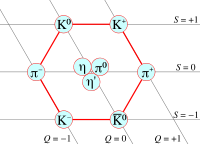 Global Information
Global InformationMeson information
 Mesons of spin 0 form a nonet | |
| Composition | composite: quarks and antiquarks |
|---|---|
| Statistics | bosonic |
| Family | hadron |
| Interactions | strong, weak, electromagnetic and gravity |
| Theorized | Hideki Yukawa (1935) |
| Discovered | 1947 |
| Types | ~140 (List) |
| Mass | from 134.9 MeV/c2 ( π0 ) to 9.460 GeV/c2 ( ϒ ) |
| Electric charge | −1 e, 0 e, +1 e |
| Spin | 0 ħ, 1 ħ |
In particle physics, a meson (/ˈmiːzɒn, ˈmɛzɒn/) is a type of hadronic subatomic particle composed of an equal number of quarks and antiquarks, usually one of each, bound together by the strong interaction. Because mesons are composed of quark subparticles, they have a meaningful physical size, a diameter of roughly one femtometre (10−15 m),[1] which is about 0.6 times the size of a proton or neutron. All mesons are unstable, with the longest-lived lasting for only a few tenths of a nanosecond. Heavier mesons decay to lighter mesons and ultimately to stable electrons, neutrinos and photons.
Outside the nucleus, mesons appear in nature only as short-lived products of very high-energy collisions between particles made of quarks, such as cosmic rays (high-energy protons and neutrons) and baryonic matter. Mesons are routinely produced artificially in cyclotrons or other particle accelerators in the collisions of protons, antiprotons, or other particles.
Higher-energy (more massive) mesons were created momentarily in the Big Bang, but are not thought to play a role in nature today. However, such heavy mesons are regularly created in particle accelerator experiments that explore the nature of the heavier quarks that compose the heavier mesons.
Mesons are part of the hadron particle family, which are defined simply as particles composed of two or more quarks. The other members of the hadron family are the baryons: subatomic particles composed of odd numbers of valence quarks (at least three), and some experiments show evidence of exotic mesons, which do not have the conventional valence quark content of two quarks (one quark and one antiquark), but four or more.
Because quarks have a spin 1/2, the difference in quark number between mesons and baryons results in conventional two-quark mesons being bosons, whereas baryons are fermions.
Each type of meson has a corresponding antiparticle (antimeson) in which quarks are replaced by their corresponding antiquarks and vice versa. For example, a positive pion (
π+
) is made of one up quark and one down antiquark; and its corresponding antiparticle, the negative pion (
π−
), is made of one up antiquark and one down quark.
Because mesons are composed of quarks, they participate in both the weak interaction and strong interaction. Mesons with net electric charge also participate in the electromagnetic interaction. Mesons are classified according to their quark content, total angular momentum, parity and various other properties, such as C-parity and G-parity. Although no meson is stable, those of lower mass are nonetheless more stable than the more massive, and hence are easier to observe and study in particle accelerators or in cosmic ray experiments. The lightest group of mesons is less massive than the lightest group of baryons, meaning that they are more easily produced in experiments, and thus exhibit certain higher-energy phenomena more readily than do baryons. But mesons can be quite massive: for example, the J/Psi meson (
J/ψ
) containing the charm quark, first seen 1974,[2][3] is about three times as massive as a proton, and the upsilon meson (
ϒ
) containing the bottom quark, first seen in 1977,[4] is about ten times as massive as a proton.
- ^ Griffiths, D. (2008). Introduction to Elementary Particles (2nd ed.). Wiley-VCH. ISBN 978-3-527-40601-2.
- ^ Cite error: The named reference
J.J. Aubert et al. (1974)was invoked but never defined (see the help page). - ^ Cite error: The named reference
J.E. Augustin et al. (1974)was invoked but never defined (see the help page). - ^ Cite error: The named reference
S.W. Herb et al. (1977)was invoked but never defined (see the help page).